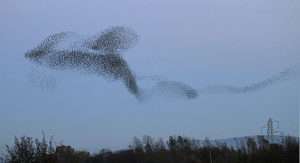I was asked a while back about why some birds fly in a V pattern, and others fly in murmurations. This got me down a rabbit hole of bird flight formations, thinking about ways I’ve seen birds fly together (or alone), and reading up on the whys and hows of some of them.
Why Do Some Birds Fly in a V Formation?
 You generally see this with pelicans, geese and other waterfowl, and other large birds, and especially (though not exclusively) during migration season. This isn’t just some simple follow-the-leader game, or safety measure. Rather, it’s all about efficiency.
You generally see this with pelicans, geese and other waterfowl, and other large birds, and especially (though not exclusively) during migration season. This isn’t just some simple follow-the-leader game, or safety measure. Rather, it’s all about efficiency.
When a bird flaps its wings, it creates little vortices of air at the tips. These essentially improve lift for a bird flying behind it, which mean that second bird can fly more efficiently. And it continues like that all the way down the line. Since both wings of the lead bird create this extra lift, the others form two lines behind the wings. These lines angle outward because the vortex created by each wingbeat actually manifests a few feet to the outside. Birds probably spend less time in the inside of the V because the various vortices created by the inner wings of two rows of flying birds might interfere with each other, whereas those created by the outer wings remain relatively undisturbed.
But there’s another cool thing about this formation: the birds time their wingbeats to best take advantage of the vortices created by those ahead of them. And it appears to be a learned behavior, rather than something instinctual; each bird figures out how to best use the lift provided by the one ahead of it. Each individual doesn’t necessarily stay in the same position the whole time; the frontrunner may eventually drop back to take a break, while another takes their place. All of which comes together to make migration a more efficient and successful journey for everyone involved.
Not all birds using this extra lift fly in a V. Brown pelicans can often be seen flying in a line, especially over water. The birds undulate up and down as they fly, as though floating over waves in the air.
In fact, that’s not too far from the truth. Similar to birds that fly in a V, the pelicans are also making use of lift. This time, though, it’s caused by updrafts created by the waves of the water. This special flight pattern is known as wave-slope soaring.
Murmurations in Swarming Starlings

I am admittedly not the biggest fan of the European starling as it’s a pretty pernicious invasive species here in the United States. However, I can appreciate what makes them unique, including their plumage, their lovely songs and mimicry, and their amazing murmurations. A murmuration is basically when a flock of starlings–sometimes thousands strong–flies as one cohesive group.
This is more amazing than I’m making it sound, though. Here’s a great video showing how the birds seem to flow through the air, and here’s one showing what happens when a hawk dives into the thick of a murmuration looking for a meal.
This latter video pinpoints one of the important purposes of flocking or swarming behavior: strength in numbers. We see it not only in birds, but also in fish, some flying insects, and other animals as well. It can be difficult for a predatory animal to home in on one individual when presented with a dizzying array of many, though if the hunter is significantly larger than the prey, it can simply swallow down lots of them at once.
But starling murmurations are also incredible because thousands of individual birds are able, without any previous planning or choreography, to fly as one without crashing into each other. It turns out it’s not some secret sixth sense–not that we’ve been able to discern yet, anyway. Instead, the birds are highly focused on those immediately around them, and each one is so responsive that as soon as one on the outer edge of the flock changes course, the others immediately follow through a rapid chain reaction that flows through the entire group in a split second.
How to See Bird Flight Formations in Action
 Fall migration is beginning, which means over the next several weeks waterfowl and other large birds will be making use of the efficiency of v-formation flight to reduce energy waste as they fly hundreds or even thousands of miles. Listen for the calls of geese as the fly overhead. If you’re along any North American coastline, watch for brown pelicans; some areas only have them during winter, while others enjoy these impressive birds year-round.
Fall migration is beginning, which means over the next several weeks waterfowl and other large birds will be making use of the efficiency of v-formation flight to reduce energy waste as they fly hundreds or even thousands of miles. Listen for the calls of geese as the fly overhead. If you’re along any North American coastline, watch for brown pelicans; some areas only have them during winter, while others enjoy these impressive birds year-round.
As for the starlings? Well, they’ve basically taken over the entirety of North America, so you can at least see individuals in almost any urban area and most rural ones as well. It may be a little easier to see murmurations in open fields and meadows as there’s more room both for the birds to fly and for you to be able to view them.
